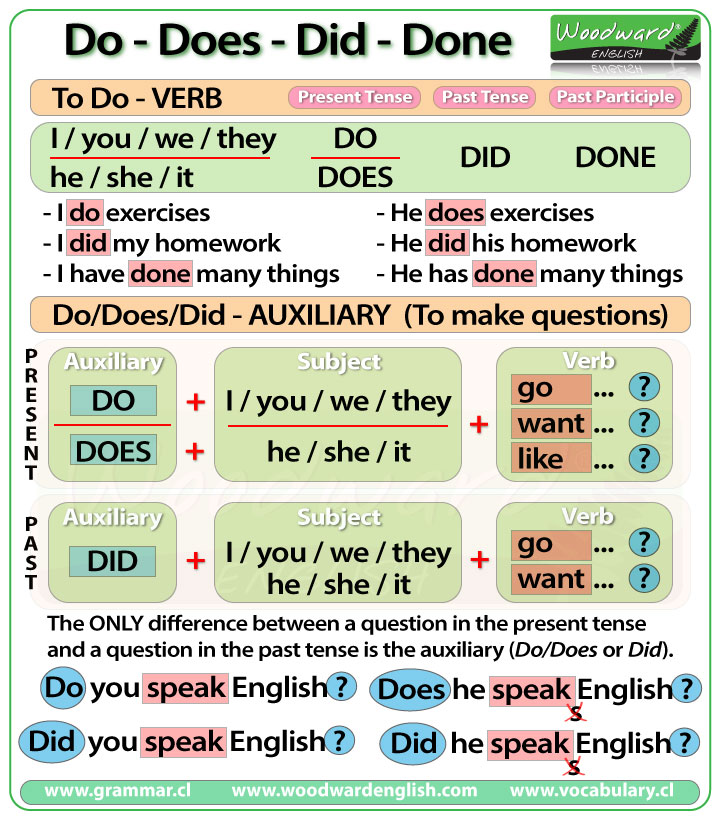DO – DOES – DID – DONE
The word DO appears a lot in English.
This is because it can be a verb, as in the verb TO DO which can be conjugated as Do and Does in the present tense, Did in the past tense and Done as a past participle.
DO can also be an AUXILIARY verb in the form of Do / Does to make questions in the present tense and Did to make questions in the past tense.
Let’s look at each one in more detail. We will start with the verb TO DO.
As we have seen, the verb TO DO has four forms: Do / Does / Did and Done
Lets look at its form in the simple present tense.
TO DO – Present Tense
With the verb TO DO in the Present Tense…
We say: I do / you do / we do / they do
But we say: he does / she does / it does
Let’s look at some example sentences:
- I do my laundry on Saturdays.
(Do my laundry means I wash my clothes, well, I put in the washing machine)
- They do their chores when they arrive home.
(Chores is the housework you need to do like washing the dishes, doing the vacuuming, etc.)
- He does nothing all day. (That’s right… he is quite lazy, he does absolutely nothing.)
- She does charity work when she has time. (People that do charity work are superheroes)
TO DO – Past Tense
The simple past tense of DO is DID for all subjects:
I did / you did / we did / they did / he did / she did / it did
Notice how there is only one form of the verb in the past tense…. DID.
- He did a magic trick. (Yes, and everyone was amazed… wooow!)
- The baby did a fart. (Yes, and the smell made everyone cry. How can such a cute thing produce something so rotten.)
- I did my homework in record time. (Yes, it only took me 5 hours instead of 10)
- She did ballet after school last year. (This year she is doing something different)
TO DO – Past Participle
The past participle of DO is DONE. Remember that past participles are accompanied by a conjugation of the verb TO HAVE or TO BE (which means it is in the correct tense according to the subject)
In general Have + past participle is used with a perfect tense and BE + past participle is with the passive voice.
Let’s look at some examples:
- I have done my homework.
- He has done a good job.
These two sentences are in the present perfect tense because they have have or has before the past participle done.
- The video will show you how it is done.
- The report was done on time.
Here we used a conjugation of the verb To Be before the past participle done.
TO DO – To replace a verb
We sometimes use the verb DO to replace a verb when the meaning is clear or obvious. This replacement is more common in informal spoken English:
- Have you done the dishes yet?
(Here done means washed)
- I’ll do the kitchen if you do the lawns
(The first do means clean – The second do means mow)
Sometimes Do, Does, and Did are used as auxiliaries to make questions in English.
Let’s start with DO and DOES:
DO / DOES – For Questions
To make a question in the simple present tense in English we normally put the auxiliary Do or Does at the beginning of the question before the subject.
After the subject is the verb in its base form which means the infinitive without TO at the beginning.
Look at this affirmative sentence:
- You speak English.
How can we make this a question? We add DO at the beginning so it becomes:
- Do you speak English?
You will see that we add DO at the beginning when the subject is I, you, we or they.
But look at this affirmative sentence:
- He speaks Arabic.
To make this a question we say:
- Does he speak Arabic?
You can see that we add DOES at the beginning when the subject is he, she or it.
Notice how the letter S at the end of the verb in the affirmative sentence (because it is in third person) disappears in the question. That is because the verb is in the base form of the infinitive.
NOTE: We DON’T use Do or Does in questions that have the verb To Be or Modal Verbs (can, must, might, should etc.)
DID – For Questions
Let’s look at the auxiliary DID.
To make a question in the Simple Past Tense in English we normally put the auxiliary DID at the beginning of the question before the subject.
And just like in the present tense, After the subject is the verb in its base form which means the infinitive with TO at the beginning.
Look at this affirmative sentence:
- You lived in Spain.
How can we make this a question? We add DID at the beginning so it becomes:
- Did you live in Spain?
We use the verb form Live and NOT lived because the auxiliary DID show that the question is in the past tense.
Did is also used with He, She and It. So with this affirmative sentence:
- She lived in Japan.
To make it a question in the past tense we say:
- Did she live in Japan?
Again we use DID for questions in the past EXCEPT with To Be and Modal Verbs such as Can.
Compare these questions:
- Do you speak English?
- Did you speak English?
The only difference between a question in the present tense and the past tense is the first part… DO or DID.
And look at these two questions
- Does he speak Italian?
- Did he speak Italian?
The only difference between a question in the present tense and the past tense when it refers to third person (he, she, or it) is the first part… DOES or DID.
Auxiliary and Verb together
Look at this question:
- Do you do exercises every day?
Why are there two DOs in this question?
The first DO is necessary because we are making a question in the simple present tense.
The second DO is from the verb TO DO. You DO exercises.
What happens if instead of YOU we are asking about another person?
- Does she do exercises every day?
We use DOES because it is necessary for simple present tense questions for third person, in this case for SHE. Does she….?
Again DO appears because you DO exercises. It appears as DO and not DOES because the verb needs to be in the base form of the infinitive.
Of course in the past tense you would say:
- Did you do exercises yesterday?
Did is an auxiliary which is needed to make a question.
Do is from the verb To Do.
DO and DOES – For Emphasis
Sometimes Do / Does / Did are used in positive sentences to give special emphasis that what you say is true, despite what the other person thinks. Note that when speaking, the word (do/does/did) is stressed.
- I do want to go. (We put stress on the word DO to emphasize that we really want to go, even if you think it is not true.)
- I did study for the test. (Contrary to what you may believe… yes, I studied)
Notice that Did is used for positive sentences in the past tense and that the main verb is in its base form.
- Yes, he does like broccoli. (You may be surprised but yes, he likes broccoli)
- You do need tickets for the event. (I am emphasizing that fact that tickets ARE needed despite what you think.)
Summary Chart

